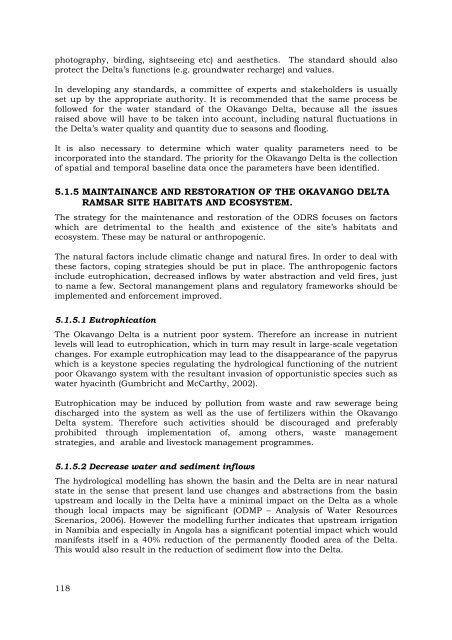Okavango Delta Management Plan - Ramsar Convention on Wetlands
Okavango Delta Management Plan - Ramsar Convention on Wetlands
Okavango Delta Management Plan - Ramsar Convention on Wetlands
You also want an ePaper? Increase the reach of your titles
YUMPU automatically turns print PDFs into web optimized ePapers that Google loves.
photography, birding, sightseeing etc) and aesthetics. The standard should also<br />
protect the <str<strong>on</strong>g>Delta</str<strong>on</strong>g>’s functi<strong>on</strong>s (e.g. groundwater recharge) and values.<br />
In developing any standards, a committee of experts and stakeholders is usually<br />
set up by the appropriate authority. It is recommended that the same process be<br />
followed for the water standard of the <str<strong>on</strong>g>Okavango</str<strong>on</strong>g> <str<strong>on</strong>g>Delta</str<strong>on</strong>g>, because all the issues<br />
raised above will have to be taken into account, including natural fluctuati<strong>on</strong>s in<br />
the <str<strong>on</strong>g>Delta</str<strong>on</strong>g>’s water quality and quantity due to seas<strong>on</strong>s and flooding.<br />
It is also necessary to determine which water quality parameters need to be<br />
incorporated into the standard. The priority for the <str<strong>on</strong>g>Okavango</str<strong>on</strong>g> <str<strong>on</strong>g>Delta</str<strong>on</strong>g> is the collecti<strong>on</strong><br />
of spatial and temporal baseline data <strong>on</strong>ce the parameters have been identified.<br />
5.1.5 MAINTAINANCE AND RESTORATION OF THE OKAVANGO DELTA<br />
RAMSAR SITE HABITATS AND ECOSYSTEM.<br />
The strategy for the maintenance and restorati<strong>on</strong> of the ODRS focuses <strong>on</strong> factors<br />
which are detrimental to the health and existence of the site’s habitats and<br />
ecosystem. These may be natural or anthropogenic.<br />
The natural factors include climatic change and natural fires. In order to deal with<br />
these factors, coping strategies should be put in place. The anthropogenic factors<br />
include eutrophicati<strong>on</strong>, decreased inflows by water abstracti<strong>on</strong> and veld fires, just<br />
to name a few. Sectoral manangement plans and regulatory frameworks should be<br />
implemented and enforcement improved.<br />
5.1.5.1 Eutrophicati<strong>on</strong><br />
The <str<strong>on</strong>g>Okavango</str<strong>on</strong>g> <str<strong>on</strong>g>Delta</str<strong>on</strong>g> is a nutrient poor system. Therefore an increase in nutrient<br />
levels will lead to eutrophicati<strong>on</strong>, which in turn may result in large-scale vegetati<strong>on</strong><br />
changes. For example eutrophicati<strong>on</strong> may lead to the disappearance of the papyrus<br />
which is a keyst<strong>on</strong>e species regulating the hydrological functi<strong>on</strong>ing of the nutrient<br />
poor <str<strong>on</strong>g>Okavango</str<strong>on</strong>g> system with the resultant invasi<strong>on</strong> of opportunistic species such as<br />
water hyacinth (Gumbricht and McCarthy, 2002).<br />
Eutrophicati<strong>on</strong> may be induced by polluti<strong>on</strong> from waste and raw sewerage being<br />
discharged into the system as well as the use of fertilizers within the <str<strong>on</strong>g>Okavango</str<strong>on</strong>g><br />
<str<strong>on</strong>g>Delta</str<strong>on</strong>g> system. Therefore such activities should be discouraged and preferably<br />
prohibited through implementati<strong>on</strong> of, am<strong>on</strong>g others, waste management<br />
strategies, and arable and livestock management programmes.<br />
5.1.5.2 Decrease water and sediment inflows<br />
The hydrological modelling has shown the basin and the <str<strong>on</strong>g>Delta</str<strong>on</strong>g> are in near natural<br />
state in the sense that present land use changes and abstracti<strong>on</strong>s from the basin<br />
upstream and locally in the <str<strong>on</strong>g>Delta</str<strong>on</strong>g> have a minimal impact <strong>on</strong> the <str<strong>on</strong>g>Delta</str<strong>on</strong>g> as a whole<br />
though local impacts may be significant (ODMP – Analysis of Water Resources<br />
Scenarios, 2006). However the modelling further indicates that upstream irrigati<strong>on</strong><br />
in Namibia and especially in Angola has a significant potential impact which would<br />
manifests itself in a 40% reducti<strong>on</strong> of the permanently flooded area of the <str<strong>on</strong>g>Delta</str<strong>on</strong>g>.<br />
This would also result in the reducti<strong>on</strong> of sediment flow into the <str<strong>on</strong>g>Delta</str<strong>on</strong>g>.<br />
118

















